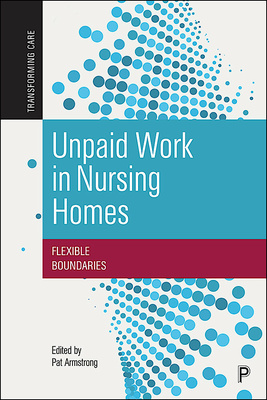By Joseph Burrell, communications officer, YFile
York University Distinguished Research Professor Emerita Pat Armstrong’s latest book, Unpaid Work in Nursing Homes: Flexible Boundaries (Policy Press, 2023), follows unpaid labourers in nursing homes across six wealthy countries, including Canada, and launches on July 18.

Armstrong, a Fellow of the Royal Society of Canada, leads a team of international researchers who have, over a decade, produced a series of books identifying hazardous trends in health-care systems as well as “promising practices for making nursing home care as good as it can be.”
“You may assume that in nursing homes most of the labour is provided by staff paid and trained for the job. But you would be wrong, especially in Canada,” Armstrong says. “This book is about who does what kinds of unpaid work, under what conditions in nursing homes. By comparing the nature and conditions of this gendered work in different countries, the book shows that the boundaries between paid and unpaid work are flexible not only for families and volunteers, but also for paid staff and residents.”
This latest entry features the results of ethnographic studies carried out in the U.S., U.K., Canada, Norway, Sweden and Germany – each country among the most resource-rich in the world and employing an array of contrasting approaches to long-term care. The follow-up entry to Armstrong’s latest book, Care Homes in a Turbulent Era (2023), also launches in August.
For all of the cultural and practical differences in each country’s approach to delivering care, a common element throughout the team’s research was that many nursing homes were dependent on unpaid labour to varying degrees.
“One of the many things that stood out for us was the amount and range of labour undertaken without pay by families, volunteers, residents and even by staff otherwise paid for the work,” Armstrong explains. “However, the amounts and kinds of unpaid work varied significantly from country to country, indicating that such work is not inevitable.”
This breadth of unremitted work, particularly the work carried out by staff who were paid in some circumstances but not in others, gave rise to the “flexible boundaries” referred to in the book’s title. Although Armstrong emphasizes that these inequities have existed in nursing homes around the world for many years – a fact demonstrated throughout the nearly 30 books that she’s published on the topic since the 1980s – she also points to the COVID-19 pandemic as a recent force stressing the limits of the workforce and illuminating the severity of workers’ situations.

As homes were quarantined and family members barred from entering, the dependence on unpaid labour became apparent to the public. But even in light of COVID-19’s global repercussions, some countries proved better equipped to handle the health crisis in nursing homes than others.
“Staffing levels are much higher in Norway and Sweden,” she says. “The ownership of care homes also differs significantly. Norway especially has very few for-profit homes while in Ontario, nearly 60 per cent are for-profit. A poll in Sweden found that a majority would like to enter a nursing home if they needed help with two or more issues, while 90 per cent of those polled in Canada say they don’t want to go into a nursing home at all.”
Noting the similarities in age demographics as well as illness prevalence across all of the countries, Armstrong suggests that differences in health outcomes and perception of nursing homes are owed to “differences in both the quality of care and values.”
Despite their comparative successes, Armstrong cautions that countries like Norway and Sweden shouldn’t rest on their laurels. According to her research, each country shares the common issue of overworking majority-female labour forces and increasingly depending on immigrants from lower-income countries to fill jobs seen as undesirable, making the problem of exploitation one that intersects with sexism, racism and classism.
“Staff members talk about lying awake at night worrying about not having had the time to help Mrs. Jones eat her dinner, to help Mr. Banerjee walk down the hall, or to comfort a daughter when her mother died, even though these staff members came in early and stayed late,” Armstrong says.
A key takeaway throughout all of Armstrong’s work is the variety of solutions applicable to these problems. Such health-care crises are mitigated not just by training more medical professionals, but by educating citizens in effective policy, like increasing public investment in long-term care facilities.
“Long before the pandemic, research had shown that for-profit care homes had the lowest staffing levels, lowest pay and lowest quality of care,” she explains. “Attending to the conditions of work is essential to… responding to the individual needs of residents. The conditions of work are the conditions of care.”
Unpaid Work in Nursing Homes: Flexible Boundaries is available for purchase in paperback format, or for free download as an e-publication, through Policy Press.


